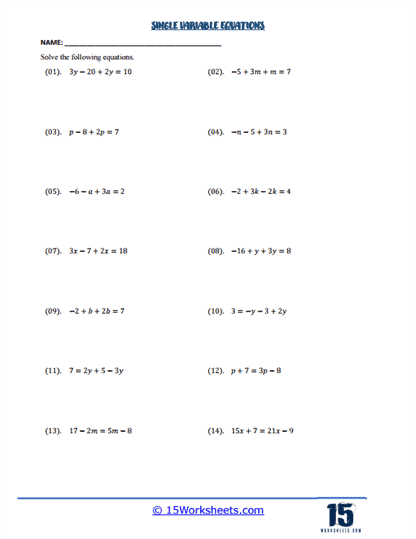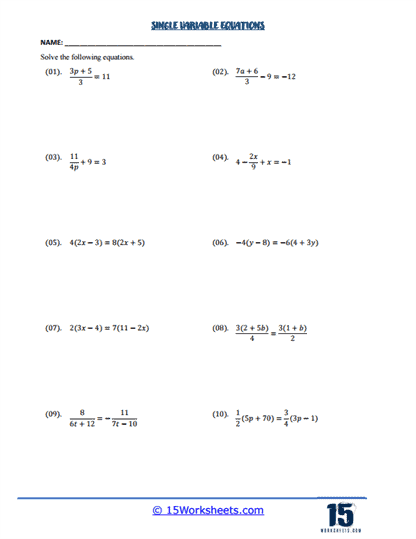Single Variable Equations Worksheets
About These 15 Worksheets
These worksheets are essential tools in teaching algebra, particularly for students in middle and high school. These worksheets offer a variety of equation types and complexity levels, helping students develop a strong foundation in solving algebraic equations. The worksheets typically include problems that require students to solve for an unknown variable using different mathematical operations. Let’s explore the different types of problems you might find on these worksheets and the math skills they help develop.
One-Step Equations
One-step equations are the simplest form of algebraic equations and are often the starting point for students learning algebra. These equations require only one operation to isolate the variable and find its value. For example, an equation like 5x = 25 can be solved by dividing both sides by 5 to find x = 5. Similarly, equations involving addition or subtraction, such as x + 3 = 7, can be solved by performing the inverse operation, in this case, subtracting 3 from both sides to find x = 4.
The primary skill taught through one-step equations is the concept of inverse operations. Students learn how to apply the opposite mathematical operation to both sides of the equation to isolate the variable. This foundational skill is crucial for solving more complex equations later on.
Two-Step Equations
Two-step equations build on the skills learned in one-step equations by requiring two operations to solve. An example might be 2x + 3 = 11. To solve this, students first subtract 3 from both sides to get 2x = 8, and then divide by 2 to find x = 4. These equations help students understand the order of operations and the importance of performing operations in a logical sequence to maintain the equation’s balance.
Through two-step equations, students enhance their problem-solving skills and learn to think critically about the steps needed to isolate the variable. They also begin to see the connection between different mathematical operations and how they can be used in tandem to solve more complex problems.
Multi-Step Equations
Multi-step equations involve more than two steps and often require students to use a combination of operations, including distribution and combining like terms. For instance, an equation like 3(x + 2) – 4 = 11 requires students to first distribute the 3, resulting in 3x + 6 – 4 = 11, then combine like terms to get 3x + 2 = 11, and finally solve for x by subtracting 2 and dividing by 3.
These equations teach students how to handle more complex algebraic expressions and develop their ability to simplify and manipulate equations. They also reinforce the importance of maintaining the equation’s balance through each step of the process.
Equations with Variables on Both Sides
Equations with variables on both sides, such as 2x + 3 = x + 5, require students to consolidate the variable terms on one side of the equation. In this example, students would subtract x from both sides to get x + 3 = 5 and then solve for x by subtracting 3 from both sides.
These problems help students understand the concept of equivalence and the importance of maintaining equality as they manipulate the equation. They also teach students to strategically choose which side of the equation to simplify, enhancing their strategic thinking and decision-making skills.
Equations Involving Fractions and Decimals
Equations that include fractions and decimals add an additional layer of complexity. For instance, solving \frac{x}{3} + 2 = 5 involves first subtracting 2 from both sides and then multiplying by 3 to eliminate the fraction. Similarly, equations with decimals require careful attention to decimal placement and operations.
These types of problems help students become comfortable with fractions and decimals in algebraic contexts, reinforcing their arithmetic skills and their ability to work with different numerical forms. They also teach students to be precise in their calculations, an essential skill in mathematics.
Word Problems
Word problems that involve single-variable equations require students to translate a real-world situation into an algebraic equation. For example, a problem might describe a scenario where a total cost is divided among several people, and students must determine the cost per person. These problems require students to identify the variable, set up the equation, and solve it.
Word problems develop students’ ability to apply algebraic concepts to real-world situations, enhancing their critical thinking and problem-solving skills. They also help students see the relevance of algebra in everyday life, making the subject more engaging and meaningful.
Absolute Value Equations
Absolute value equations, such as |x – 3| = 5, require students to consider both the positive and negative solutions that satisfy the equation. In this example, students must solve for both x – 3 = 5 and x – 3 = -5, leading to two potential solutions for x.
These problems teach students about the concept of absolute value and how it represents distance from zero on a number line. They also help students understand that equations can have more than one solution, broadening their understanding of algebraic concepts.
Proportions and Percentages
Equations involving proportions and percentages often require students to solve for a variable within a ratio or percentage context. For example, solving the equation x/100 = 0.75 involves multiplying both sides by 100 to find x = 75.
These problems help students understand the relationship between fractions, decimals, and percentages, and how they can be used interchangeably in mathematical contexts. They also reinforce the concept of scaling and proportional reasoning, important skills in both algebra and real-world problem-solving.















